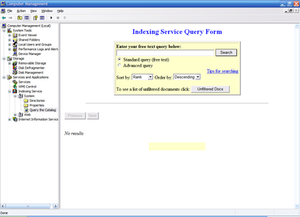Indexing Service
In this article, we will explore the topic of Indexing Service in order to analyze its impact and relevance in today's society. Indexing Service has been the subject of interest and debate in various areas, whether in the academic, social, cultural or political spheres. Its influence has been significant in the way people perceive and approach certain problems, as well as in the way they function in their environment. Throughout this text, we will examine different aspects related to Indexing Service, from its origin and evolution to its possible implications for the future. This article aims to provide a comprehensive and comprehensive view on Indexing Service, in order to promote a deeper and more reflective understanding of this topic.
 The Indexing Service Query Form, used to query Indexing Service catalogs, hosted in Microsoft Management Console. | |
| Developer(s) | Microsoft |
|---|---|
| Operating system | Microsoft Windows |
| Successor | Windows Search |
| Service name | Indexing Service |
| Type | Desktop search |
Indexing Service (originally called Index Server) was a Windows service that maintained an index of most of the files on a computer to improve searching performance on PCs and corporate computer networks. It updated indexes without user intervention. In Windows Vista it was replaced by the newer Windows Search Indexer. The IFilter plugins to extend the indexing capabilities to more file formats and protocols are compatible between the legacy Indexing Service how and the newer Windows Search Indexer.
History
Indexing Service was a desktop search service included with Windows NT 4.0 Option Pack as well as Windows 2000 and later. The first incarnation of the indexing service was shipped in August 1996 as a content search system for Microsoft's web server software, Internet Information Services.[citation needed] Its origins, however, date further back to Microsoft's Cairo operating system project, with the component serving as the Content Indexer for the Object File System. Cairo was eventually shelved, but the content indexing capabilities would go on to be included as a standard component of later Windows desktop and server operating systems, starting with Windows 2000, which includes Indexing Service 3.0.
In Windows Vista, the content indexer was replaced with the Windows Search indexer which was enabled by default. Indexing Service is still included with Windows Server 2008 but is not installed or running by default.
Indexing Service has been deprecated in Windows 7 and Windows Server 2008 R2. It has been removed from Windows 8.
Search interfaces
Comprehensive searching is available after initial building of the index, which can take up to hours or days, depending on the size of the specified directories, the speed of the hard drive, user activity, indexer settings and other factors. Searching using Indexing service works also on UNC paths and/or mapped network drives if the sharing server indexes appropriate directory and is aware of its sharing.
Once the indexing service has been turned on and has built its index it can be searched in three ways. The search option available from the Start menu on the Windows Taskbar will use the indexing service if it is enabled and will even accept complex queries. Queries can also be performed using either the Indexing Service Query Form in the Computer Management snap-in of Microsoft Management Console, or, alternatively, using third-party applications such as 'Aim at File' or 'Grokker Desktop'.[citation needed]
References
- ^ a b Nareddy, Krishna (15 October 1997). "Introduction to Microsoft Index Server". Microsoft Developer Network. Microsoft Corporation. Retrieved 1 February 2011.
- ^ "Indexing Service Version 3.0". Microsoft Developer Network. Microsoft Corporation. Retrieved 1 February 2011.
- ^ Danseglio, Mike; Dillard, Kurt; Maldonado, José; Robichaux, Paul (December 2005). Bannecker, Reid; Cobb, John; Tobey, Jon; et al. (eds.). Threats and Countermeasures: Security Settings in Windows Server 2003 and Windows XP (Microsoft Word) (2.0 ed.). Microsoft Corporation. p. 144.
- ^ "What is Indexing Service?". Microsoft Developer Network. Microsoft Corporation. Retrieved 1 February 2011.
- ^ a b "About the Indexing Service". Microsoft. Retrieved 10 August 2018.
- ^ "How to install and configure the Indexing Service on a Windows Server 2008-based computer (Revision: 3.0)". Microsoft Support. Microsoft Corporation. 3 May 2010. Retrieved 1 February 2011.
- ^ "Deprecated Features for Windows 7 and Windows Server 2008 R2". Windows 7 Technical Library. Indexing Service: Microsoft Corporation. 16 October 2009. Retrieved 8 November 2011.